- Case Studies
- Carson Road, West Dulwich, London
Carson Road, West Dulwich, London
Introduction
Knox Bhavan Architects was appointed to remodel a Victorian house in Dulwich which had been poorly converted into three flats in the 1960s and to reconvert it into a family home. The house - three storeys with a semi-basement - had to be completely gutted before refurbishment could commence. Simple, carefully detailed joinery using responsibly sourced timber articulates the remodelled house, introducing clean modern lines while enhancing its Victorian elegance.
Building description
The house has an imposing central entrance door on the street facade, reached by a flight of steps and a new York stone terrace. To one side is a new single-storey extension with curved corners, clad with vertical boards of Siberian larch; the same material is used to clad the adjacent bin-store and garden trellis.
The rear elevation is given a new symmetry with new European oak sash windows and at ground floor level, with European oak French doors and bay windows.
Internally, a natural palette of European oak and limestone floors unite the house from top to bottom and provide a complementary background to the bespoke joinery.
Entering the house the eye is drawn to the new staircase which runs the full height of the house. The staircase structure consists of a cast aluminium chassis which supports shaped European oak treads with open risers, allowing light to flood through the centre of the house and create a visual connection through the family living space to the garden beyond. An oiled American black walnut handrail with hand carved turns and a carved end volute contrasts with the lighter oak treads and the bead blasted aluminium balusters.
The kitchen and dayroom
Down the first flight of stairs, the open plan kitchen and dayroom introduce a modern feel to the Victorian house. Reflecting the design of the library, the dayroom is fitted with shelves and a bureau on the end wall. The wall which faces the garden is panelled with European oak and incorporates a pair of outward opening double French doors at the centre and on either side, a 2 metre wide x 2.6 metre tall bay window seat with sliding folding shutters, all made from European oak. The bay windows give increased space and light, while providing a place to sit and talk. Each bay window projects 620mm from the rear wall and has hinged side-opening lights. All have double glazed units with an inner leaf of Low E glass. A tube heater is positioned below the window seat and heat is dispersed through an oak grille at the back of the seat, an integral part of the joinery. The bay window has built-in three-leaved shutters which can be closed at night for privacy or used for shading. They are made of oak-veneered MDF and incorporate magnets to hold them in place. The shutters are operated by the use of a simple sliding mechanism which slides them in front of the side window, after which they can be unfolded across the main fixed glazed window. The adjoining double French doors also have shutters; they are simple hinged doors which can be folded back flush with the panelled wall or - at night or for security - folded shut and locked. In this position they merge with the panelling alongside, creating an elegant and warm panelled wall to match the bay windows and shelves.
At the opposite end of the room, the kitchen area has bespoke kitchen units with European oak veneered drawers and spray painted MDF door and drawer fronts, finished with Burlington slate worktops.
In the basement European oak-veneered shelving contrasts with the dark blue walls and seating to create a club-like games room for the client’s children. In contrast a much lighter feel is achieved in the utility room where ash is the principal material.
The library and music room
To the left of the entrance hall is the library. This room is lined on three sides with European oak veneered shelves; they frame a Lappia Green marble-backed fireplace into which a clean-burning wood stove has been fitted. A bureau is built in to the right hand side of the fireplace.
On the right of the entrance is the music room. It is fitted with cupboards of MDF painted a bright gloss yellow, which frame a black piano. The cupboards were designed to accommodate a variety of musical instruments, accessories and sheet music.
The bedrooms
Upstairs the master suite is divided into bedroom, dressing room and bathroom by cedar-lined, cherry slip-matched veneered cupboards providing clothes storage. The doors to the rooms fit neatly back against the cupboards which stop short of the ceiling, so that the rooms read as a unity.
In the attic a sauna is given a contemporary look with tongued and grooved hemlock cladding which contrasts with the pale aspen seating. Both timbers were chosen for their particular suitability to this application.
Choice of timber
It was important to both architect and client that the timber used in the building was from a sustainable source and FSC certified. Where appropriate European timber was preferred over timber from further afield.
Siberian Larch was chosen to clad the small external extension as it is durable and hard wearing.
Engineered European oak was used for exterior joinery - new windows, French doors and bay windows - to take advantage of its rich, warm colour, its durability and its workability (the additional cost of the material was compensated for by the ease of working). European oak was also used for the staircase treads and as a veneer to shelves and cupboards downstairs.
The dark tone of American black walnut was chosen for the handrail to contrast with the lighter-coloured European oak treads. Its workability was very important given the turned handrail.
In the utility room, ash was chosen for its light colour and straight grain. MDF was used in the music room and elsewhere for its ease of working and stability. Tulipwood was specified for the architraves to doors for its ease of working.
Upstairs in the dressing room, cherry wood was specified for cupboards and drawers for its warm colour and attractive figuring, with cedar cupboard and drawer linings, chosen for its moth repellent properties.
In the top-floor sauna, it was important that the timber chosen for seating and walking on had a low sap content to ensure that it will not get too hot to sit or stand on. Obeche is often used in this application, however both architect and client had concerns about being able to source this from proven sustainable sources. Therefore aspen was chosen for benches and duckboards as an attractive and sustainable alternative. It was quite difficult to get hold of as it is commonly used in the USA but much less so in the UK. The hemlock cladding to the sauna was chosen as it can tolerate extreme changes in temperature. Durable and resistant to decay, its even, straight grained, darker reddish colour contrasts well with the aspen benches and duckboards.
The refurbished house was the winner in the ‘Private’ category of the Wood Awards 2009. The judges commented: ‘A beautifully detailed suburban family home using a variety of timbers and contractors. It is a real credit to the practice and to the young architect, who clearly lived and breathed this project and, through working closely with the client and contractors, has achieved the highest quality of detail and workmanship.’
2008
Year Published:June 2010
Building Type:House refurbishment
Location:West Dulwich, London
Client:Private client
Architect:Knox Bhavan Architects
Structural Engineer: Main Contractor:Aakash Builders
Joinery:Ian Dunn Woodwork & Design, Palmer Joinery, Unibuild
Timber Element(s):Cladding, windows and doors, staircase and interior fittings
Timber Specie(s):European oak, American black walnut, cherry, cedar, aspen, ash, hemlock, Siberian larch
Awards(s):Winner, Wood Award 2009, Private category
Suggested Reading
Standards Update October 2017
An update of British, European and International Standards relating to timber, including new and revised Standards, those withdrawn or amended and drafts now available for public comment, updated bimonthly.
30/10/2017
Standards Update April 2017
An update of British, European and International Standards relating to timber, including new and revised Standards, those withdrawn or amended and drafts now available for public comment, updated bimonthly.
13/07/2017
Understanding the regulations governing windows and doors
Mark Milner outlines the energy efficiency improvements of the latest guidelines.
Article from Timber 2017 Industry Yearbook
15/06/2017
























